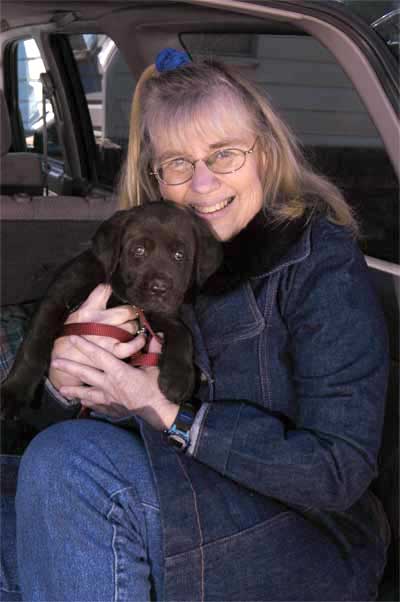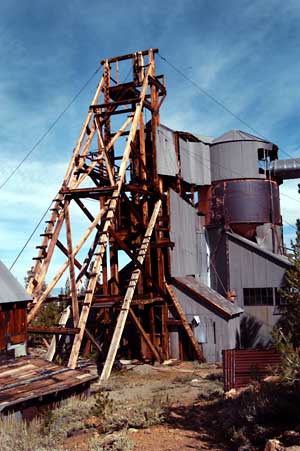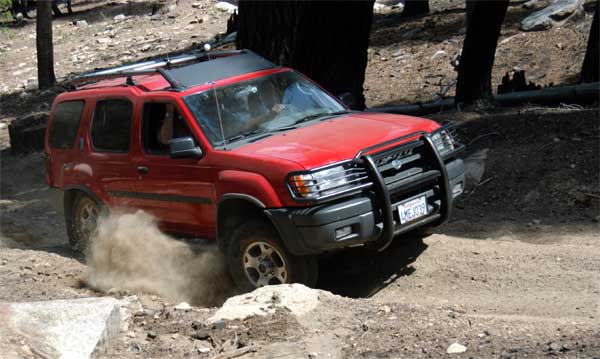

|
|
Maggie
Moore Joins Explore Historic California Crew |
|
 Seven
week old Maggie poses with Cecile.
Seven
week old Maggie poses with Cecile.

Big
Dog Jessie June, 1989-Nov. 4, 2003
|
This
month we introduce our new trail dog, seven week old Maggie Moore. Maggie comes to us from MMRANCH, thanks to Monty Messer. Her father was a yellow
Labrador, and her mother a pure rottweiler, which makes her a fine rottador.
Maggie hopes to follow in the paws of our Big Dog Jessie, who
passed away on
November 4, 2003
.
With
a little luck and some training
she will become as fine a trail companion as Jessie was. Poor Little
Jake, now known as Papa Jake, hopes to give Maggie
writing lessons, so she can tell you about Madam Maggie Moore who owned
the Waterfall up at Cerro Gordo. Sadie,
has taken over as Maggie’s surrogate mother and can hardly wait to
take her on her first romp in the Piutes in June. We’re sure you’ll be seeing and hearing more from Maggie
Moore herself, in the coming months. She’s a great addition to our family and our Explore Historic
California crew!
|
|
Lost
Mines of the Western Mojave by
Cecile Page Vargo |
|
The
first mining stories out
of the
El Paso
Mountains
in the Western Mojave talk of discoveries
in the narrow canyon known today
as
Goler
Canyon
or Goler Gulch. There are
many different versions of the original story.
The most popular tells
of John Goler crossing
over the arid
Mojave desert
after surviving the horrors of
Death Valley
in 1849. Weakened from thirst
and hunger, Goler and companion found
a few gold nuggets as they were looking for water.
Supposedly,
Goler was so afraid of Indians he hurried away, but had time to leave
his gun to mark the spot where he had found the nuggets.
When he was safe and sound in
Los Angeles
he began displaying the gold and a small map where he had supposedly
found them. Future investors
were told there would be no problem locating Goler’s potential gold
mine because of that gun he had
left standing on the hill
at the canyon mouth.

Goler’s
Lost Gold
Goler
and a man named Grant P. Cuddeback set
out with a well equipped party of men to find the fast becoming famous
canyon. Unfortunately, the
Mojave desert
turned out to be riddled with many canyons that fit the description of
the one on Goler’s map, and no gun could be found at the entrance to
any of them. The now
disgruntled party, returned to
Los Angeles
, none the richer for their efforts. Still positive he could
re-discover the area where he had found his gold nuggets, Goler
organized another party, only to be disappointed a second time.
Throughout the years that followed, freighters coming back and
forth from the successful mining camps north of Mojave, told stories
of seeing a lonely man and his burro prospecting in the eastern
El Paso
foothills. While camping at
Mesquite Springs, Freighter
“Slate Range Jack” ran into Goler with more nuggets said to have
been found 5 miles to the east of them.
Many a man outfitted himself with prospecting supplies and
headed into the Western Mojave in search of
“The Lost Gunsight Mine” or
“Goler’s Lost Gold. In
1893, when a bonanza was finally found in a dry narrow gulch in the
Southern El Paso Mountains, many believed that this was the
site of John Goler’s
lost mine, and named the camp that grew up around it Goler.
Read more
|
|
Can
This Mine be Saved?
You
Can Make a Difference |

Tucked away in the
Sierra Nevada
Mountains
high above the
Mono
Basin
is an almost completely intact mine and mill.
Legend has it that two prospectors wondered up the mountain and
discovered gold, but one miner was killed in an avalanche before they
could do anything with the claim. The year would have been1890, and
the original file on this
claim was listed as the Mendocino.
The mine and mill were active through the 1980’s.
Until recently, only a few tried and true ghost towners or
local residents have ventured up the dusty dirt road, and explored the
area. Most refused to talk much about it in fear that less mindful
people would haul everything away. Today, the
Inyo
National Forest
and the Mono Basin Historical Society have joined hands in efforts to
preserve what remains. Plans are in the making to make this area safe
for general public access to this important part of
California
’s mining history. Buildings
are being locked and safety hazards removed.
Plexiglas may replace glass windows for viewing the complicated
mining machinery inside these buildings. Interpretive signs may be put
up to help visitors identify what they are seeing.
There’s even talk that a
caretaker will stay at the site during the summer months.
The Mono Basin Historical Society is spearheading the
preservation efforts for this nearly forgotten mine and mill, but they
can’t do this alone. If enough interest from people who care
about preserving our mining history is not shown, there is a
possibility that these efforts will stall, and this historic site will
fall victim to the harsh winter weather and to the vandals and
souvenir hunters who have discovered it.
Please e-mail us at info@explorehistoricalif.com
or contact Don Banta of the Mono Basin Historical Society
(760-647-6627) or mbhs@qnet.com, or
the
Inyo
National Forest
(760-647-3044), if you would like to
help save this endangered mine and mill.
Volunteers are also needed to help
collect oral or written histories from old timers that actually
worked in this mine.
Read more
|
|
Our Tours with
Ecological 4-Wheeling Adventures |
|

We're climbing into 2004!
Please check
here for our 2004 tour schedule.
|
|
Explore Historic California! |
|
Not too many years ago, the family station wagon was the
magic carpet to adventure. Today, that family station wagon is likely to
be a four wheel drive sport utility vehicle or pick up truck. SUV's and
other 4x4's are one of the best selling classes of vehicles. Ironically,
industry statistics show that once purchased, few owners will dare to
drive their vehicles off the paved highway. Click your mouse through our
website and enjoy our armchair adventures and the histories behind them.
If you are interested in taking one of our guided tours with your
vehicle, please visit our ECOLOGICAL 4-WHEELING ADVENTURES.
Several years ago, we bought our first SUV. We went to a one-night class
at a local community college entitled "How to 4-Wheel Drive" by Harry Lewellyn.
The following weekend we attended the hands-on day tour. We liked what we were
doing so much that we began going out nearly every weekend and learned how to
negotiate a variety of dirt roads. Our spare time was spent doing research on
the history and ecology of our favorite areas. A one-day outing turned into 15
years of leading others on mini-vacations throughout Southern California and the
Owens Valley.
Our 4WD outings involve driving on easy to moderate dirt roads and are
ideally suited to novice and intermediate level drivers. All tours are suitable
for stock vehicles in good condition, although some tours do have vehicle size
restrictions.
Our tours are
operated under permits issued by the Bureau of Land Management, U.S.
Forest Service, and other authorities.
We share our knowledge of the backcountry over the CB radio with our
guests. We frequently stop to explore mining areas, old and new, and ponder the
rocks, plants and animals we may encounter. We'll occasionally visit an old
cabin or deserted mountain lookout.
California has a fascinating history, from geologic unrest and
prehistoric petroglyph scribes to the "Radium Queen of the Mojave" and the
"Human Mole of Black Mountain." Load up your 4X, fasten your seatbelts and get
ready to explore historic California.
Roger, Cecile and Marty |

|
|

